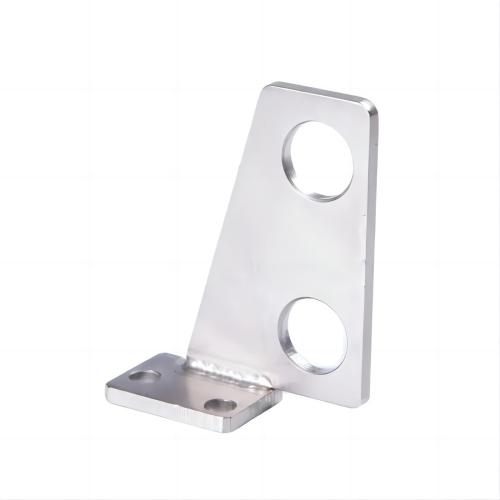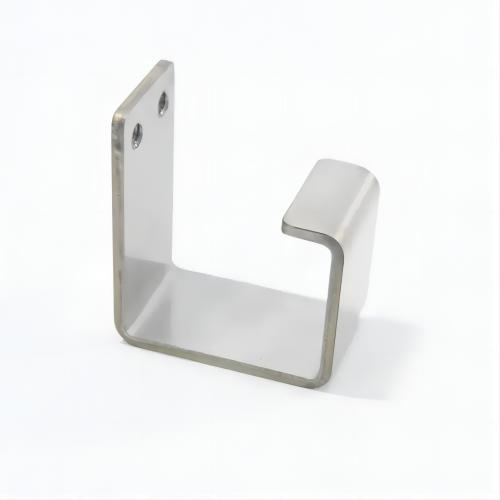
Need laser-cut sheet metal parts that adhere strictly to specifications without increasing costs?
If so, this guide is for you.
It covers everything you need to know about sheet metal laser cutting.
What Is Sheet Metal Laser Cutting?

Laser cutting
Laser cutting is a CNC (computer numerical control) technique in precision sheet metal fabrication. It uses high-power laser beams to cut sheet metal into exact specifications.
The cutting technique uses an adjusted focus light and an assist gas. The light and gas typically burn any metal into the desired shape or size.
Sheet metal laser cutting can be a little complex. However, it offers speed, precision, and versatility that are second to none.
You cannot compare it to other sheet metal cutting techniques.
Sheet Metal Laser Cutting Process
Here is how a typical laser cutter looks:
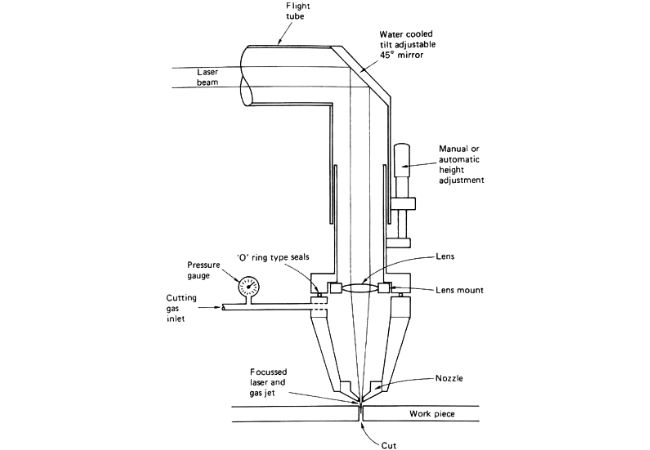
Laser cutter
So how does it work?
A laser cutter, as I have said, is computer-numerically controlled.
The cutting process begins with a computer program that directs a high-intensity laser beam onto the material to be cut.
Mirrors in various positions direct the laser onto the workpiece (metal to be cut).
A high-quality lens then focuses the intense beam on a small spot on the surface of the workpiece. This tiny spot is first pierced before a cut is made.
Now here’s an interesting fact:
A laser beam is made up of photons. A typical beam is about 1/5 of a millimeter wide. The beam also concentrates 1000 to 2000 watts of energy
That’s a pretty large amount of energy in one beam.
Now imagine what it can do.
When the intense beam of light hits that part of the material, it heats up. This causes the area to melt, burn, or vaporize, even if the heat isn’t enough.
And when this happens, it leaves a very accurate outline per the initial CAD design.
Take a look at the video below:
Types Of Laser Machines To Use In Sheet Metal Laser Cutting
There are several options to choose from if you want to invest in a laser machine for sheet metal cutting:
Flying Optic Laser Cutting Machine
Flying optic laser cutters are one of the market’s fastest yet inexpensive cutting equipment.
They project a powerful beam of light that can cut along a metal sheet’s X and Y axes.
Their high speed and multi-dimension capability allow you to cut many workpieces in a short period.
Moving Material Laser Cutting Machine
A moving material laser cutter projects a stationary light beam.
This machine connects workpieces to a mobile surface that moves automatically in preprogrammed directions. Programming the directions is done using computers.
Although accurate and precise in cutting sheet metal, this equipment tends to be much slower than others.
Punch Laser Cutting Machine
These high-power laser cutting machines can cut metal with up to 3500 watts.
Punch laser cutters can perform various tasks such as punching, marking, contouring, and bending. Their primary purpose is to cut intricate inner contours and outer parts.
Pulsed Laser Cutting Machine
This sheet metal laser cutting machine produces high power output for a short period. Their ability to project high amounts of power in a short time makes them perfect for piercing.
Types Of Laser Used In Cutting Sheet Metal
Sheet metal laser cutting machinery uses one of three types of lasers:
- C02 Laser: This laser is ideal for cutting, boring, and engraving on metal. These lasers cut mild steel, aluminum, stainless steel, and titanium using radio frequency energy. They are ideal for industrial applications.
- Nd YAG Laser (Nd-YAG Laser (Neodymium Yttrium Aluminum Garnet): YAG lasers are perfect for high-power boring and engraving. These lasers are powerful enough to engrave on strong metals like tungsten, steel, titanium, chromium, and iron.
- Nd Laser (Neodymium): Nd and Nd-YAG lasers are essentially the same in terms of style. However, the application process differs.
Unlike the YAG lasers, an Nd laser works best for low repetition and high energy applications. - Fiber Laser: A fiber laser is a solid-state laser that uses a solid gain medium instead of a gas or liquid. In this system, seed laser beams are amplified inside glass fibers. Fiber lasers, note, are not that common in metal fabrication.
Advantages Of Laser Cutting Sheet Metal
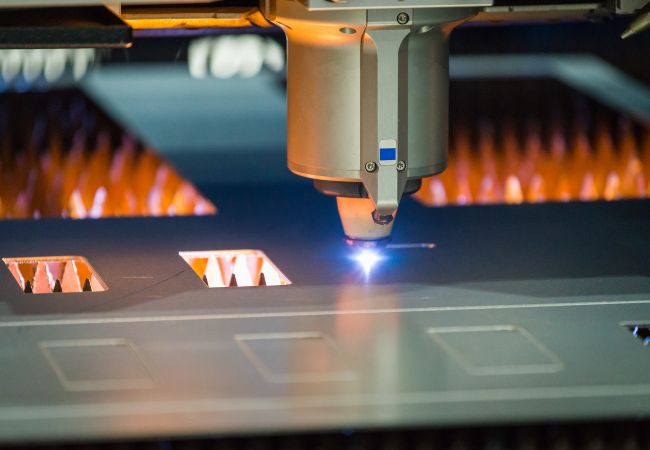
Sheet metal laser cutting
Sheet metal laser cutting offers several advantages.
First, using this technology can reduce manufacturing costs. It does this by eliminating the need for machining in some engineering jobs.
This technology also offers a high level of precision. It allows you to create complicated shapes.
Laser cutting will not contaminate work pieces either. The likelihood of warping in materials is significantly less as well.
Besides, some metals you simply cannot cut using any other technique.
Other advantages of sheet metal laser cutting are:
- High-grade overall finish quality
- Provides narrow kerf widths
- Offers high-speed cutting
- Minimal material wastage
- Eliminates the need for any secondary finishing operations
- Requires minimal operator intervention
Disadvantages Of Laser Cutting Sheet Metal
Despite its many advantages, sheet metal laser cutting technology has some downsides.
The main disadvantage is that the process often requires a lot of power.
Also, when using a laser cutter, the more wattage, the deeper the cutting ability.
When cutting thinner metals, lasers are high-speed and accurate.
In thicker metals, however, “heat zones” can develop. Some metals may melt or become uneven if this occurs.
As a result, laser cutting thicker metals is not feasible. Not only because of possible damage to the material but because it is more costly.
Overexposure to lasers can cause heat zones or hot spots. In this case, parts may need further processing to achieve the desired results. Labor, material, and energy costs will go up as a result.
How To Reduce Sheet Metal Wastage During Laser Cutting
When laser cutting sheet metal, it’s essential to keep waste to a minimum to ensure cost efficiency.
Your company will save money and minimize landfill waste by controlling sheet metal material waste. You will also reduce emissions caused by the unnecessary use of laser-cutting machines.
Here is how you can reduce material waste during laser cutting:
- Keep workpieces close together during cutting. Since it’s a CNC process, nesting parts together minimizes material waste.
- Make your design drawing more efficient by introducing shared cut lines. Place rectangular edges so that they share straight lines on the part rather than creating unnecessary spaces between shapes.
This method not only eliminates waste but also shortens the cutting path of the laser cutter, reducing run time and cost. - Avoid intricate designs. Unnecessarily complex shapes and curves slow down laser cutting, resulting in material waste.
Offcuts are unavoidable in many sheet metal fabrication processes.
It is possible, however, to maximize the use of offcuts and avoid waste in laser cutting. You can, for instance, reuse it to cut out smaller, more delicate parts or for test runs.
Just make sure you store your offcuts properly so they’re ready for your next laser-cutting project.
Sheet Metal Laser Cutting Tolerances

Sheet metal laser cutting tolerances
Do you recall that laser cutting uses a concentrated monochromatic light beam to cut sheet metal?
Good!
This technology allows for extremely tight tolerances. This capability is suitable for precision metal parts, like those used in automotive, aerospace, and military applications.
Laser cutters often have dimensional tolerances as tight as ± 0.0005 inches.
They are potentially the most precise and can have the smallest kerf (or cutting width).
Moreover, these tools can cut thin material (16 gauge or thinner) faster than other tools. A more powerful laser-cutting machine can cut mild steel up to 1.25 inches thick.
However, it is essential to remember that tighter tolerances increase the cost of laser cutting custom sheet metal parts.
So unless your part requires tight tolerances for form, fit, or function, you should avoid them.
How To Ensure Quality During Sheet Metal Laser Cutting
The quality of the laser cutting equipment determines to a large extent the quality of the cuts you produce.
If you maintain your laser cutter regularly, irregularities in the cutting process will be reduced
However, your laser cut parts will only be of the highest quality if you consider the cutting parameters.
What are these parameters?
- Metal thickness: The metal’s nature and thickness must match the laser cutter’s relative wattage. This is the key to better results when laser cutting sheet metal.
- Surface roughness of the material: the smoother the surface of the material when laser cutting sheet metal, the better the cutting results. So if you want to maintain good cutting quality, use materials whose surfaces are smooth and free of rust.
- Cutting speed: the laser cutting speed should neither be too fast nor too slow, as this will affect the quality of the cut. Therefore, be sure to consider the thickness and composition of the material when determining the cutting speed.
- Cutting focus: the positioning of the focusing lens is critical for good laser cut quality. Only by focusing accurately can you achieve the best cutting results.
These four elements are critical to ensuring that laser-cutting processes for sheet metal meet established standards.
It is necessary to control these parameters when you perform several dozen identical positions simultaneously. This way, you avoid making the same mistakes in your cuts.
Design Tips For Your Laser Sheet Metal Cutting
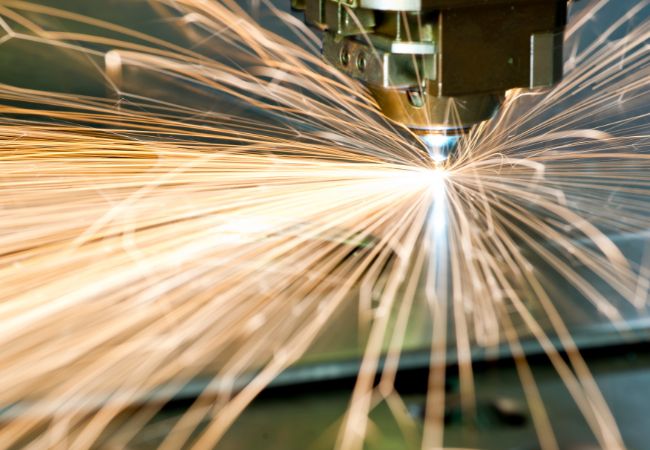
Sheet metal laser cutting process
If you’re ready to use sheet metal laser cutting, here are some tips to help your design turn out the way you want it to.
- Use the right design software. To create a proper design for metal laser cutting, you will need a vector file (usually in .ai, .eps, or dxf format). Adobe Illustrator is a good tool for creating designs. Both beginners and professionals can benefit from this design tool.
- Keep your drawing simple. Avoid sharp angles, usually anything less than ten degrees. The laser may not be able to accurately execute such sharp curves, which will result in a more rounded final product.
- Make sure your design is full scale (1:1). Otherwise, you’ll end up with a small part that’s more suitable for a toy than its intended purpose.
- Consider the type of material. Use metal materials that are appropriate for the application you plan to use them for.
Aluminum, for example, does not rust and makes beautiful signs. However, the material is very soft and flexible. Commercial and industrial laser cutting commonly uses steel.
Tips On How To Choose Good Sheet Metal Laser Cutting Service
Your sheet metal laser cutting project could start great things for your business. Choosing a company that offers high-quality services will go a long way to ensuring the quality of your final products.
But how do you choose the best laser-cutting service for your job?
Look for the following features when selecting the right company: experience, services, proper design, materials, equipment, and accreditations
- The company should provide you with special CAD software for free, so you can have the exact part made. You should be able to use the software to design a part from scratch or adapt an existing design to your needs.
- Choose a company that can handle the material you need laser cut.
- It should have high-quality machinery to produce parts that perfectly match your designs. Also, the cutting equipment should be durable and reliable. This will reduce the risk of interruptions during production.
- The company should provide you with excellent technical support to solve any problems quickly. It will make your job much easier if you can count on the help of the company you are working with.
- Check if the company makes it easy for you to order the product so that you save a lot of time and effort.
- Cost is also a critical factor. The price at which you purchase the laser-cut parts will affect the selling price of your product. However, do not make the mistake of hiring a company based on cost alone. This could affect quality and availability.
- The service provider you choose must be accredited for their services and the quality of the products they deliver. The standard accreditation is ISO 9001:2015 and BS/EN 1090-1.
An accredited laser-cutting company will provide you with quality products that meet industry standards. - Choose a laser cutting service whose sales engineers know their stuff. Working with a service provider with a well-trained sales staff will ensure that your work is done to the highest standard, quickly, and cost-effectively.
Sheet metal laser cutting is, as I said, a complex task. You will only be satisfied with the result if you carefully choose the company you work with.
The company should be able to understand your vision and design an appropriate product without hassling you too much.
It should then be able to execute the designs, paying attention to even the smallest details, so you’re delighted with the finished product.
Galvanized Sheet Metal Laser Cutting
For galvanized sheet, laser cutting machine can easily cut.
Conclusion
Sheet metal laser cutting produces accurate and complex parts. It is one of the best technologies for sheet metal fabrication process.
Contact us now if you need sheet metal laser cutting.
We have a specially trained team ready to handle all your laser-cutting needs.
More Resources:
Laser Cutting Parts – Source: KDM
Sheet Metal Laser Cutting – Source: KDM
Tube Laser Cutting 101 – Source: KDM






